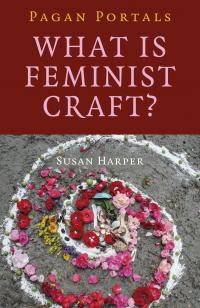
 December in the Wheel of the Year Part 1: Christmas Trees, Crowleymass and Krampus Night By Lucya Starza
December in the Wheel of the Year Part 1: Christmas Trees, Crowleymass and Krampus Night By Lucya Starza
I happen to know that Moon Books Editor Trevor Greenfield loves a Yule tree and was among the first this year to get decorating. The fact that more people put their trees up at the start of December than on the 24th – as used to be traditional – demonstrates how folk customs are constantly changing. As I’m sure most people are aware, Christmas trees only became popular in England after Queen Victoria and Prince Albert had one in their home in 1848. Steve Roud in The English Year explains they were seen in England before that, but weren’t common. An older midwinter way to deck the house with greenery was to hang a kissing bough from the ceiling. Roud wrote: “One thing the Victorians didn’t invent was kissing under the mistletoe.”
Kissing boughs are wooden hoops hung with greenery, especially mistletoe, and were once the centerpiece of seasonal decorations. It was also said a maid would dream of her future husband if she put mistletoe under her pillow and that the plant protected homes from lightning. Pliny wrote that the ancient druids considered mistletoe sacred, but kissing boughs aren’t a direct continuation of any ancient pagan practices. Christians happily brought mistletoe into their homes without considering it heretical, even though nowadays some vicars ban it as too pagan.
In Stations of the Sun, Professor Ronald Hutton wrote that in England, Christmas trees were adopted as a secular and family-centric way to enjoy Christmas in the mid 19th century rather than a religious thing. It really means that pagans, Christians and atheists can happily bring evergreens into the home without arguments about whose tradition it belongs to.
Tree Dressing Day
The first weekend in December in England is National Tree Dressing Day, honouring those in the wild rather than ones we take indoors. It isn’t an ancient pagan custom, but was introduced in 1990 by arts and environmental group Common Ground. On its website, Common Ground wrote:
“Trees…carry stories and put us in our place, outliving us if we let them, by many generations. In towns especially, they help to clean the air, fix carbon, reduce noise and flash flooding, provide oxygen, shade, beauty and attract wild life, yet are under constant threat from vandals, vehicles, and over-cautious councils and insurance companies. Often we take them for granted, and feel sad if we have acted too late to save them.”
Tree Dressing Day draws on many seasonal, magical and spiritual customs from all over the world, as well as Yuletide traditions. Some involve decorating trees, such as the Japanese practice of attaching strips of white paper, or tanzaku, bearing wishes and poems, and the Buddhist tradition of tying ribbons around the Bodhi tree in homage to Buddha. There are folkloric customs in Britain of attaching tiny strips of natural fabric to trees as clooties or clouties and to be disintegrated by the elements, but nowadays that’s controversial. As most pagans are aware, too many well-meaning but misguided people tie manmade fabric to trees, which doesn’t rot. A build-up of stuff can damage branches and harm wildlife. This is very much against the ethos of Tree Dressing Day. You’re better off putting bird food and slices of fruit outdoors for wildlife to enjoy. Common Ground says Tree Dressing Day is a chance for people to reflect on the social and cultural history of their area, and the role trees have played in shaping this story. Learning where it is and isn’t appropriate to dress trees, and what will help the environment rather than damage it further, can be part of that opportunity.
Moving on from trees, here are some other anniversaries in early December.
Crowleymass
It might seem odd to hold a party in honour of someone’s death, but The Atlantis Bookshop in London has a tradition of doing that to remember one of their famous – some would say infamous – customers. Aleister Crowley died on December 1, 1947. He’s long been toasted by London’s esoteric community on that anniversary, although the shop is taking a break from hosting a party this year due to pandemic concerns. Atlantis Bookshop proprietor and Crowley expert Geraldine Beskin is the proud owner of the occultist’s hat, which can sometimes be seen on display. Aleister Crowley was the creator of the Thoth Tarot, while on 14 December, 1910, the Rider-Waite-Smith tarot was first published. In the Moon Books community book Every Day Magic, Sheena Cundy offers some tarot magic:
“Tarot spell for opportunity: Light a candle and place the Magician card on your altar. Visualize your intention, draw a horizontal figure of eight; with symbols representing your desire inside the two circles. Retrace while chanting: ‘I place into the lemniscate/Opportunities to create/Harmonising magically/As I will so mote it be!’”
Krampusnacht or Krampus Night
Dark folklore is another thing that’s seen a rise in interest in recent years, and the Krampus has become popular outside the regions he originally came from. In Germany and other central European countries on December 5, the night before the Feast of St Nicholas, the Krampus sorts good children from bad. The monstrous figure with horns is said to beat naughty children, put them into a sack, or even eat them. Krampusnacht is nowadays an excuse for carnival-type celebrations. People dress up as the Krampus or as Frau Perchta, a Nordic folktale character and possibly an aspect of the fertility goddess Freyja. The Krampus himself is possibly a version of the son of Hel, Norse god of the underworld, who Christians conflated with the Devil. Another suggestion is he’s a dark version of the Yule Goat, a Scandinavian figure associated with the harvest and often represented in straw effigies.
These days December is the busiest month of the year for most people, pagan or not. There’s so much to cover in terms of seasonal customs and lore that I’ll writing a few more blog posts than usual this month on the Wheel of the Year.
This is part of a series of posts I’m writing for the Moon Books Blog on the theme of the Wheel of the Year. They will be compiled and edited into a book: Pagan Portals – Wheel of the Year. Other books by Lucya Starza in the Pagan Portals series include Candle Magic, Guided Visualisations, Poppets and Magical Dolls, and Scrying. Lucya edited the community book Every Day Magic – A Pagan Book of Days.
Categories:
0 comments on this article






